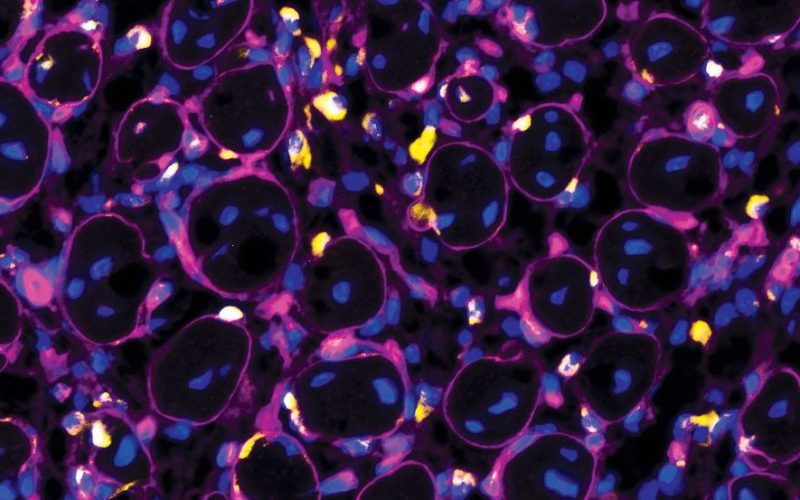Researchers from the groups of Jeroen Bakkers (Hubrecht Institute/UMC Utrecht) and Peter Currie (Monash University, Australia) discovered a factor that triggers muscle stem cells to proliferate and heal. In a mouse model of severe muscle damage, introduction of this naturally occurring protein led to the complete regeneration of muscle and the return of normal movement after severe muscle trauma. The discovery may lead to faster recovery from muscle injury and wasting diseases. The study was published in Nature on the 10th of February.
When we tear a muscle – stem cells within it repair the problem. We can see this occurring not only in severe muscle wasting diseases such as muscular dystrophy, but also in our day to day lives when we “pull” a muscle. Also when we age and become frail, we lose much of our muscle and our stem cells do not seem to be able to work as well as we age. These muscle stem cells are invisible engines that drive the tissue’s growth and repair after such injuries. But growing these cells in the lab and then using them to therapeutically replace damaged muscle has been frustratingly difficult.
Researchers from the groups of Jeroen Bakkers, group leader at the Hubrecht Institute, and Peter Currie, director of Monash University’s Australian Regenerative Medicine Institute in Melbourne, have now discovered a factor that triggers these muscle stem cells to proliferate and heal. In a mouse model of severe muscle damage, introduction of this naturally occurring protein led to the complete regeneration of muscle and the return of normal movement after severe muscle trauma.
By studying the cells that migrated to a muscle injury in zebrafish, the scientists identified a group of immune cells, called macrophages, which appeared to have a role in triggering the muscle stem cells to regenerate. “What we saw were macrophages literally cuddling the muscle stem cells, which then started to divide and proliferate. Once they started this process, the macrophages would move on and cuddle the next muscle stem cell, and pretty soon the wound would heal,” Currie said.
Macrophages are the cells that flock to any injury or infection site in the body, removing debris and promoting healing. “They are the clean-up crew of the immune system,” says Currie. Further investigations revealed that the “cuddling” macrophage released a substance called NAMPT. By removing the macrophages from the zebrafish and adding the NAMPT to the aquarium water the scientists found they could stimulate the muscle stem cells to grow and heal – effectively replacing the need for the macrophages. Importantly, experiments placing a hydrogel patch containing NAMPT into a mouse model of severe muscle wasting led to significant replacement of the damaged muscle. The researchers are now in discussion with a number of biotech companies about taking NAMPT to clinical trials for the use of this compound in the treatment of muscle disease and injury.
“This was a very fruitful collaboration between Monash University and the Hubrecht Institute and it is very exciting to see that macrophages play such an important role during skeletal muscle regeneration,” says Bakkers. Phong Nguyen, one of the other researchers on the project, adds: “We use our muscles every day for simple tasks such as getting out of bed, but also more intensive activities such as sports. These activities can cause small to large injuries and it is reassuring to know that the other cells in our body are helping these muscle stem cells do their job.” Macrophages also play important roles during heart regeneration, which is extensively studied in the Bakkers group. “This work may also contribute to more knowledge about the role of macrophages in the heart,” Bakkers concludes.
Macrophages provide a transient muscle stem cell niche via NAMPT secretion. Dhanushika Ratnayake, Phong D. Nguyen, Fernando J. Rossello, Verena C. Wimmer, Jean L. Tan, Laura A. Gavlis, Ziad Julier, Alasdair J. Wood, Thomas Boudier, Abdulsalam I. Isiaku, Silke Berger, Viola Oorschot, Carmen Sonntag, Kelly L. Rogers, Christophe Marcelle, Graham J. Lieschke, Mikaël M. Martino, Jeroen Bakkers & Peter D. Currie. Nature (2021).
Jeroen Bakkers is group leader at the Hubrecht Institute and professor of Molecular Cardiogenetics at the University Medical Center Utrecht.
Peter Currie is professor and director of Research at The Australian Regenerative Medicine Institute at Monash University in Melbourne, Australia.
